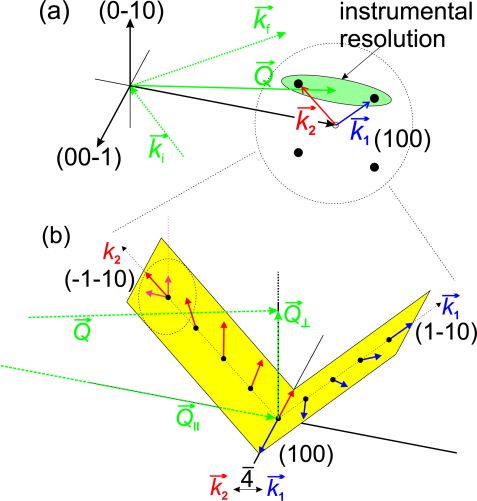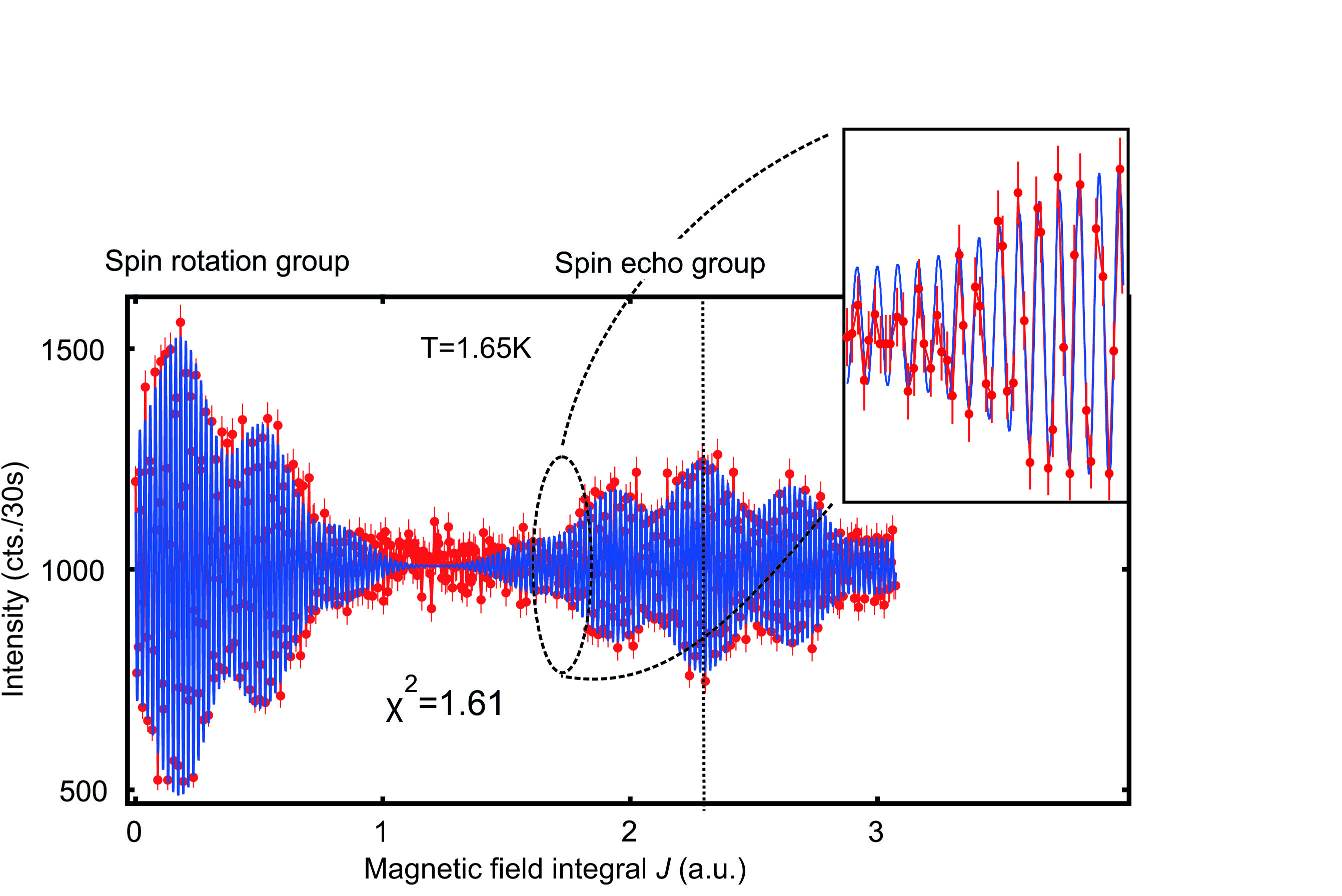MLZ ist eine Kooperation aus:
 > Technische Universität München
> Technische Universität München > Helmholtz-Zentrum Hereon
> Helmholtz-Zentrum Hereon
 > Forschungszentrum Jülich
> Forschungszentrum Jülich
MLZ ist Mitglied in:
 > LENS
> LENS > ERF-AISBL
> ERF-AISBL
MLZ in den sozialen Medien:

MLZ
Lichtenbergstr.1
85748 Garching
Static and quasi-elastic properties of the spiral magnet Ba2CuGe2O7 studied by NRSE spectroscopy
S. Mühlbauer1, J. Kindervater2, W. Häußler1,2
1 Heinz Maier-Leibnitz Zentrum (MLZ), Technische Universität München, Garching, Germany
2 Physik-Department, Technische Universität München, Garching, Germany
We provide a novel route for using elastic and quasi-elastic neutron spin echo spectroscopy (Larmor labeling) for a unified approach to the study of both the static and dynamic properties of incommensurate magnetic structures with small propagation vectors. The archetypal non-centrosymmetric spiral magnet Ba2CuGe2O7 serves as a model system for our study. We show how Larmor labeling can efficiently decouple instrumental wavelength-resolution and effective Q-resolution and give high precision access to the structural properties of the incommensurate domains of Ba2CuGe2O7.
Properties of incommensurate spiral magnetic structures
Spiral magnetic structures have aroused great scientific interest over the last decade, not only due to their multiferroic [1] and topological properties [2]. The phase transition into spiral magnetic phases can be of special interest [3]: If critical magnetic fluctuations soften at finite momentum transfer, an otherwise 2nd order phase transition may be driven first order. This scenario, recently found to be substantiated in the helimagnet MnSi [4], is relevant for incommensurate magnetic structures in general. As the Brazovskii scenario is exclusively based on phase space considerations, it is an interesting open question as to whether it is also applicable to systems with lower dimension.
A possible candidate for such considerations is the non-centrosymmetric tetragonal antiferromagnet (AF) Ba2CuGe2O7 (P421m), which shows an incommensurate spiral magnetic structure, provided by the Dzyaloshinskii-Moryia interaction. Below TN=3.2K and at zero magnetic field, neutron diffraction has established an incommensurate, almost AF cycloidal magnetic structure in the (a, b)-plane with ξ = 0.0273 (see Fig. 1). Four magnetic satellite reflections indicative of two degenerate magnetic domains are observed at (1±ξ, ±ξ,0), centered at the AF Neel point (1,0,0) [5, 6]. The phase transition from paramagetism to spiral long-range order is characterized by an interplay of 2D physics and Brazovskii correlations. In a magnetic field, Ba2CuGe2O7 exhibits a multitude of different incommensurate magnetic structures, hints for weak FM behavior and weak ferroelectricity [5, 6, 7, 8].
Larmor labeling and NRSE spectroscopy on incommensurate magnetic structures

Figure 1: (a: Schematic depiction of the experimental setup: The momentum transfer Q is aligned almost parallel to (1,0,0) along (1±ξ, ±ξ,0). The instrumental resolution is given by the shaded green ellipsoid. (b): Illustration of both AF cycloidal magnetic domains of Ba[~2~]CuGe[~2~]O[~7~] with propagation vectors (±1,-1,0). For clarity, only one sublattice is drawn. Both domains are related by the symmetry operation 4.
In a text-book experiment, we show how neutron Larmor labeling on the NRSE spectrometer RESEDA @ MLZ can be used for a close examination of the magneto-structural properties of the incommensurate spiral magnetic structures of Ba2CuGe2O7 [9]. Moreover, we report on first quasi-elastic measurements where we study the linewidth of the diffraction peaks associated with the decay of the cycloidal magnetic order upon crossing TN.
To this end, we calculate the general case of elastic and quasi-elastic neutron spin echo measurements from incommensurate helical, cycloidal and elliptical magnetic structures with polarizing properties: As the resolution in Q space of a typical neutron spin echo spectrometer is limited by the velocity selector generally used on such instruments, the interference effects that arise due to the overlap of multiple incommensurate domains have to be considered. A characteristic beating of the spin echo signal as a function of the precession field is expected from theory.
When applied to the special case of Ba2CuGe2O7 , the characteristic beating of the spin echo signal as a function of the precession field is accurately confirmed by our experiment (see Fig. 2). This beating allows for efficient decoupling instrumental wavelength-resolution and effective Q-resolution and gives precise access to the structural properties of incommensurate domains. Looking at quasi-elastic measurements of the diffraction peaks associated with the cycloidal spin spiral of Ba2CuGe2O7 , we find hints for a broadening of the linewidth at TN whereas below TN, no dynamic processes are observed [9].
We have shown experimentally and theoretically that a characteristic beating of the spin rotation and spin echo signal, which is caused by the polarizing properties of the sample, allows for precise measurement of the incommensurate propagation vectors otherwise inaccessible by instrumental resolution. Our study introduces a way of using this Lamor labeling technique on neutron spin echo spectrometers as a general approach for the investigation of the structural and quasi-elastic properties of incommensurate magnetic structures of different kinds. It is worth noting that the limitation to samples with polarizing properties can be avoided by the installation of an additional neutron polarizer after the sample region. However, tight technical restrictions apply to the neutron polarizer used for this purpose, as the flight path of the neutrons must not be affected.

Figure 2: Elastic spin rotation signal and spin echo signal, recorded at a temperature of T = 1.65 K and for a spin echo time of τ = 0.08 ns. Red data points correspond to the measured points. The fitted model is shown in blue. The inset depicts a zoomed version of the recorded data points and the corresponding fit function.
References:
[1] M. Mostovoy, Phys. Rev. Lett. 96, 067601 (2006).
[2] S. Mühlbauer et al., Science 323, 5916, 915 (2009).
[3] S. A. Brazovskii, Sov. Phys. JETP 41, 85 (1975).
[4] M. Janoschek et al., Phys. Rev. B 87, 134407 (2013).
[5] S. Mühlbauer et al., Phys. Rev. B 84, 180406 (2011).
[6] S. Mühlbauer et al., Phys. Rev. B 86, 024417 (2012).
[7] H. Murakawa et al., Phys. Rev. Lett. 103, 147201 (2009).
[8] J. Chovan et al., Phys. Rev. B 88, 064421 (2013).
[9] S. Mühlbauer et al., Phys. Rev. B 92, 224406 (2015).
MLZ ist eine Kooperation aus:
 > Technische Universität München
> Technische Universität München > Helmholtz-Zentrum Hereon
> Helmholtz-Zentrum Hereon
 > Forschungszentrum Jülich
> Forschungszentrum Jülich
MLZ ist Mitglied in:
 > LENS
> LENS > ERF-AISBL
> ERF-AISBL
MLZ in den sozialen Medien:


